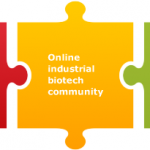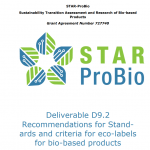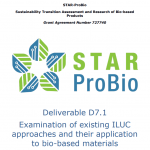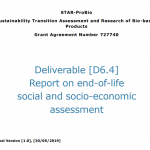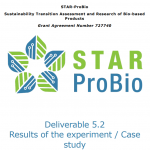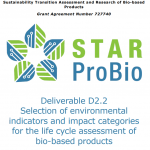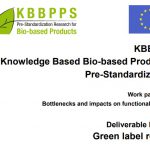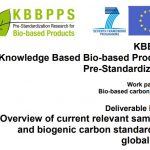Category: Standardisation, LCA, labelling and regulatory hurdles
BIO-TIC Non-technological roadmap
The BIO-TIC project comprehensively examined the innovation hurdles in industrial biotechnology (IB) across Europe and formulated action plans and recommendations to overcome them. The projects is built on three pillars: an online industrial biotech community, an assessment of biomass and sustainability in industrial biotech, and an action plan for industrial biotech in Europe. As part of the action plan for industrial biotech three roadmaps to overcome barriers were developed: Market roadmap, R&D roadmap and Non-Technological roadmap.
The non-technological roadmap identifies regulatory and non-technological hurdles that may prevent IB innovation from taking advantage of market opportunities., and proposes solutions for key market entry barriers.
Deliverable D9.2: Recommendations for standards and criteria for eco-labels for bio-based products
The European Bioeconomy Strategy aims at achieving an innovative, resilient and low carbon economy that replaces fossil raw materials with biological ones, promoting resource efficiency and contributing to a more sustainable economy. Bio-based industries are aware of the need to create trust in bio-based products by implementing suitable measures to support their market uptake and by providing consumers with appropriate information on their characteristics. Eco-labels offer great opportunities to provide such consumer information, and in this report, a list of key eco-label criteria and standardisation options for selected case studies have been considered and analysed. Based on four case studies, the report provides a number of recommendations, which also address broader public policy and existing regulations and mechanisms. They also highlight the need to update other independent mechanisms and labels.
Deliverable D7.1: Examination of existing iLUC approaches and their application to bio-based materials
The STAR-ProBio project aims to identify and mitigate the risks of negative Land Use Change (LUC) effects associated with the production routes of biobased products. This report details the initial steps in this process which were firstly to assess the status quo and key findings of existing approaches to quantify GHG emissions due to dLUC (direct Land Use Change) and iLUC (indirect Land Use Change) in order to identify, categorise and structure the key drivers and parameters for future strategies to reduce iLUC risks in a developing bioeconomy. The capacity of existing models to cover bio-based materials was then assessed, and links between the key drivers for iLUC and standardisation work related to the sustainability of biofuels and biomaterials were also identified. The outcome of this research has been used to identify specific risk factors that control land expansion (intensive margin, land suitability, co-products, demand elasticity, export – trade elasticity, trade share, supply elasticity) and establish the initial outline of a conceptual model to account for iLUC using a risk-based approach that will be developed further within the STAR-ProBio project.
Deliverable 6.4: Report on end-of-life social and socio-economic assessment
End of Life (EoL) management represents a great challenge to develop new opportunities towards sustainability. Indeed, international institutions, organizations, academics, researchers and practitioners highlighted the importance of EoL management, since it is associated with relevant environmental, social and economic impacts. Yet, the appraisal of EoL alternatives represents a particularly complex task to address due to the difficulties arising from the assessment of social and economic key-criteria. In this regard, several gaps related to bio-based products have been stressed by the literature, especially with reference to socio-economic indicators. This report focuses on the existing EoL options with the aim of identifying key community priorities for sustainable EoL management of bio-based products. This is achieved by developing a win-win asset-based model that has been tested on a selected case study, i.e. Poly Lactic Acid (PLA)-based packaging film. The results show that recycling (both mechanical and chemical) is the best EoL option for the considered product.
Deliverable D5.2: Results of the experiment / Case study
Efforts to promote a sustainable bioeconomy seek to enable markets that create value from renewable resources while satisfying sustainability requirements. Despite recent progress in several European countries in launching strategies to support a bioeconomy, market demand for bio-based products remains moderate. More analysis is required to better understand the drivers and barriers for enabling consumer demand for bio-based products, in particular as this relates to consumers’ sustainability concerns. A previous report developed within the scope of the STAR-ProBio project has presented the results of two rounds of a Delphi survey aimed at better understanding the sustainability preferences of procurement professionals and end consumers. Building on these results, the following tasks were completed: a third and final round of the Delphi survey was conducted with procurement professionals and a framed field experiment was conducted with end consumers to identify their willingness to pay a premium for different types of bio-based products with and without sustainability certification. This report presents the results from these tasks. In particular, it covers findings on the following: i) the relevance of information on final disposal and ii) preferences regarding information on the bio-based raw materials used, including questions related to the share and origin of bio-based raw materials and the form in which this information is communicated. In addition, the report discusses survey results on sustainability principles and potential policy options to promote the demand for bio-based products. The field experiment conducted on three products, i.e. coloured pens, hand soap and food storage bags shows that on average end consumers assign a higher price for bio-based products than conventional ones.
Deliverable D2.2: Selection of environmental indicators and impact categories for the life cycle assessment of bio-based products
This report describes an environmental life cycle assessment (E-LCA) methodology developed by STAR-ProBio for biobased products that is based on selected relevant life cycle impact assessment (LCIA) methodologies and their respective environmental indicators. The chosen hierarchical assessment criteria for selection of the methodologies were defined as 1) ability be used for comparing bio-based materials amongst themselves and for comparing bio-based materials against conventional petrochemical products, 2) Scientific relevance, 3) Political and social priority, 4) Reliability and robustness, 5) Representativeness and 6) Stakeholder and market perception. A final set of 11 indicators and associated models are recommended to be used for the environmental assessment of bio-based materials and be tested through the STAR-ProBio case studies.
Green Label report
This report presents the results of the desk research of ecolabels that can be relevant for biobased products carried out within Task 5.4 of KBBPPS. The main objective of this task was to analyse existing green labels for the selected products (Task 5.1) and to discuss the possible conflicts of including bio-based carbon or biomass content in these labels.
Market entry barriers
The main focus of this research was on technical bottlenecks for BBP stemming from regulations, codes, norms and standards, but another aspect of the analysis were also barriers in the process chain such as access to raw materials, unsuitable political framework, lack of information, inappropriate communication and labelling as well as finance.
The main aim was to check whether existing product specifications, test standards, certifications and labelling present hurdles to bio-based variants.
Overview of current relevant sampling and biogenic carbon standards on global level
In the following report all relevant standards on a global level are reviewed with respect to the biogenic carbon content determination. In general it is an overview of all standards that can be used when determining the biogenic carbon content and will give directions when no relevant standards are available.
This review is focused in all standards concerning the sampling, pre-treatment and 14C determination of all product types, which includes solids, liquids, gasses and mixtures of these.


